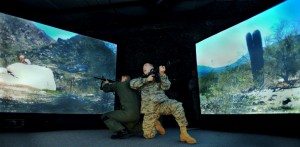JOINT BASE MCGUIRE-DIX-LAKEHURST, N.J.: Airmen preparing for the worldwide mobility mission of the 621st Contingency Response Wing here now have a powerful new training tool.
A state-of-the-art virtual firearms training simulator with a 300-degree field of view is now being operated by members of the 819th Global Support Squadron to prepare CRW Airmen for the deployed environment. This high-definition interactive shoot room provides realistic and safe weapons training with much more speed and flexibility than a standard firing range, said Master Sgt. John MacDonald, 819th GSS Force Protection Flight non-commissioned officer-in-charge.
Due to their rapid and worldwide expeditionary nature, contingency response Airmen may find themselves operating in hostile locations, whether in traditional war zones or in the aftermath of a large natural disaster. While deployed, every mobility Airman is responsible for contingency base defense and force protection duties. This immersive $250,000 simulator allows Airmen to receive advanced training in-house before stepping off the plane into the unknown, and can be tailored to the various environments they might encounter.
 “The computer system will allow us to create our own scenarios based on feedback from deployed teams,” said Sergeant MacDonald. “This means our Airmen receive more of the training they need and spend less time traveling to various training sites.
“The computer system will allow us to create our own scenarios based on feedback from deployed teams,” said Sergeant MacDonald. “This means our Airmen receive more of the training they need and spend less time traveling to various training sites.
“The simulator allows us to quickly move from marksmanship training to close-quarters battle tactics to decision making under stress type drills in seconds,” he added. “We can even run these (scenarios) in any weather condition or under low light conditions. The many variations available to us are changing the way we prepare for our missions and allow us to pack a lot of realistic training into a single session.”
Airmen also will be able to use their own issued weapons to train, said 1st Lt. Ryan Hengel, the 819th GSS Mission Support Flight commander.
“We can pull the member’s assigned weapon from our vault and make it compatible with the system,” he said. “We also use a special magazine that contains a battery and gas source to cycle the weapon and provide recoil. We can turn any unit-issued duty weapon into a computerized training aid in minutes. The system even allows us to create weapons malfunctions from the training control station.
“An Airman can zero their weapon in the trainer so it will be ready for them when they deploy,” Lieutenant Hengel added. “The computer shows virtual rounds exactly as real bullets would act in actual weather, wind and altitude conditions. This allows the CRW Airmen to perform marksmanship training and weapons familiarization drills with awesome results. We have a 100 percent requalification rate for Airmen who have come through here for additional instruction.”
The simulator uses a set of five rear-projection high-definition screens and large speakers arranged into a hexagon. The sixth section serves as a doorway into the training space. Once inside, a wide variety of simulations can be loaded, from indoor and outdoor target ranges, homes, vehicles and battlefields in many environments ranging from the mountains of Afghanistan to a village in Eastern Europe.
The setup also is flexible and portable. It can be arranged around a combat vehicle for convoy skills and counter-improvised explosive device training for a vehicle crew or arranged in a straight line to create a traditional style shooting range for up to 20 trainees. When it needs to be moved, it only takes about four hours to unpack, set up and begin training. Any darkened space roughly the size of a basketball half-court can house the simulator
The system has an added element not found in previous shooting simulators. In combat, the price of a mistake or inattention can be steep. This virtual space provides a painful reminder that keeps trainees focused and alert, Lieutenant Hengel said.
Trainees wear a box about the size and weight of a portable radio on their belts. If the trainer determines an Airman has reacted too slowly or has made a decision that gets him injured or killed, the box delivers an electric shock lasting anywhere from .2 to 2.5 seconds. Point-two seconds feels like a bee sting. Two-point five seconds will temporarily incapacitate a trainee, simulating a battlefield fatality.
“It’s certainly an effective deterrent,” said Capt. Frank Rovello, the 21st Air Mobility Operations Squadron Readiness Flight commander, after a training session April 15.
“That shock was the longest two-and-a-half seconds of my life,” he said. “I didn’t drop my weapon and still managed to get my shots off to drop my target, but it definitely had me paying attention.
“It’s not every day a training session gets your palms all sweaty and your heart racing like that,” he added. “The realism was eye opening.”









